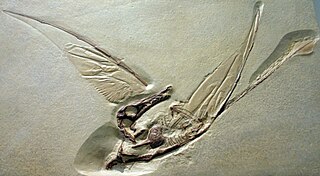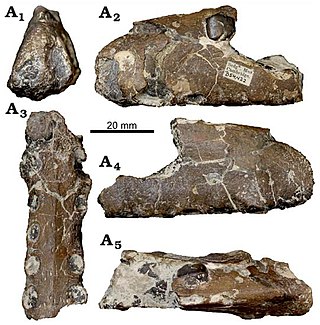
Pterosaurs is an extinct clade of flying reptiles in the order Pterosauria. They existed during most of the Mesozoic: from the Late Triassic to the end of the Cretaceous. Pterosaurs are the earliest vertebrates known to have evolved powered flight. Their wings were formed by a membrane of skin, muscle, and other tissues stretching from the ankles to a dramatically lengthened fourth finger.

Pteranodon ; from Ancient Greek πτερόν and ἀνόδων is a genus of pterosaur that included some of the largest known flying reptiles, with P. longiceps having a wingspan of over 6 m (20 ft). They lived during the late Cretaceous geological period of North America in present-day Kansas, Nebraska, Wyoming, South Dakota and Alabama. More fossil specimens of Pteranodon have been found than any other pterosaur, with about 1,200 specimens known to science, many of them well preserved with nearly complete skulls and articulated skeletons. It was an important part of the animal community in the Western Interior Seaway.

Quetzalcoatlus is a genus of azdarchid pterosaur known from the Late Cretaceous Maastrichtian age of North America. Its two confirmed species, along with other azdarchids, were the largest known flying animals of all time. Azhdarchidae is a family of advanced toothless pterosaurs with unusually long, stiffened necks and giant wingspans. Its name comes from the Aztec feathered serpent god Quetzalcoatl. The type species is Q. northropi, named by Douglas Lawson in 1975. The genus also includes the smaller species Q. lawsoni, which was known for many years as an unnamed species, before being named by Brian Andres and Wann Langston Jr. (posthumously) in 2021.

Paul B. MacCready Jr. was an American aeronautical engineer. He was the founder of AeroVironment and the designer of the human-powered aircraft that won the first Kremer prize. He devoted his life to developing more efficient transportation vehicles that could "do more with less".

Azhdarchidae is a family of pterosaurs known primarily from the Late Cretaceous Period, though an isolated vertebra apparently from an azhdarchid is known from the Early Cretaceous as well. Azhdarchids included some of the largest known flying animals of all time, but smaller cat-size members have also been found. Originally considered a sub-family of Pteranodontidae, Nesov (1984) named the Azhdarchinae to include the pterosaurs Azhdarcho, Quetzalcoatlus, and Titanopteryx. They were among the last known surviving members of the pterosaurs, and were a rather successful group with a worldwide distribution. By the time of the end-Cretaceous mass extinction, most pterosaur families except for the Azhdarchidae disappear from the fossil record, but recent studies indicate a wealth of pterosaurian fauna, including pteranodontids, nyctosaurids, tapejarids and several indeterminate forms. In several analyses, some taxa such as Navajodactylus, Bakonydraco and Montanazhdarcho were moved from Azhdarchidae to other clades.

Scleromochlus is an extinct genus of small pterosauromorph archosaurs from the Late Triassic period. The genus contains the type and only species Scleromochlus taylori, named by Arthur Smith Woodward in 1907.

Pterodactyloidea is one of the two traditional suborders of pterosaurs, and contains the most derived members of this group of flying reptiles. They appeared during the middle Jurassic Period, and differ from the basal rhamphorhynchoids by their short tails and long wing metacarpals. The most advanced forms also lack teeth, and by the late Cretaceous, all known pterodactyloids were toothless. Many species had well-developed crests on the skull, a form of display taken to extremes in giant-crested forms like Nyctosaurus and Tupandactylus. Pterodactyloids were the last surviving pterosaurs when the order became extinct at the end of the Cretaceous Period, together with the non-avian dinosaurs and most marine reptiles.
Dermodactylus was a genus of pterodactyloid pterosaur from the Kimmeridgian-Tithonian-age Upper Jurassic Morrison Formation of Wyoming, United States. It is based on a single partial bone, from the hand.

Pterodactyl was the name given to a series of experimental tailless aircraft designs developed by G. T. R. Hill in the 1920s and early 1930s. Named after the genus Pterodactylus, a well-known type of Pterosaur commonly known as the pterodactyl, all but the first were produced by Westland Aircraft Ltd after Hill joined them.

Lonchodectes was a genus of lonchodectid pterosaur from several formations dating to the Turonian of England, mostly in the area around Kent. The species belonging to it had been assigned to Ornithocheirus until David Unwin's work of the 1990s and 2000s. Several potential species are known; most are based on scrappy remains, and have gone through several other generic assignments. The genus is part of the complex taxonomy issues surrounding Early Cretaceous pterosaurs from Brazil and England, such as Amblydectes, Anhanguera, Coloborhynchus, and Ornithocheirus.

Lost Continent is a 1951 American black-and-white science fiction film drama from Lippert Pictures, produced by Jack Leewood, Robert L. Lippert, and Sigmund Neufeld, directed by Sam Newfield, that stars Cesar Romero, Hillary Brooke, Whit Bissell, Sid Melton, Hugh Beaumont and John Hoyt.

Rhamphorhynchidae is a group of early pterosaurs named after Rhamphorhynchus, that lived in the Late Jurassic. The family Rhamphorhynchidae was named in 1870 by Harry Govier Seeley. Members of the group possess no more than 11 pairs of teeth in the rostrum, a deltopectoral crest that is constricted at the base but expanded at the distal end, and a bent phalange on the fifth toe.

Kunpengopterus is a genus of wukongopterid pterosaur from the middle-late Jurassic Tiaojishan Formation of northeastern China. The genus contains two species, the type species K. sinensis and K. antipollicatus.

The Chengdu GJ-1, also known as Wing Loong 1, is a Medium-Altitude Long-Endurance (MALE) unmanned aerial vehicle (UAV), developed by the Chengdu Aircraft Industry Group in the People's Republic of China. Intended for use as a surveillance and aerial reconnaissance platform, the Pterodactyl I is capable of being fitted with air-to-surface weapons for use in an unmanned combat aerial vehicle (UCAV) role.

Pteranodontoidea is an extinct clade of ornithocheiroid pterosaurs from the Early to Late Cretaceous of Asia, Africa, Europe, North America and South America. It was named by Alexander Wilhelm Armin Kellner in 1996. In 2003, Kellner defined the clade as a node-based taxon consisting of the last common ancestor of Anhanguera, Pteranodon and all its descendants. The clade Ornithocheiroidea is sometimes considered to be the senior synonym of Pteranodontoidea, however it depends on its definition. Brian Andres in his analyses, converts Ornithocheiroidea using the definition of Kellner (2003) to avoid this synonymy.

Lonchodraco is a genus of lonchodraconid pterodactyloid pterosaur from the Late Cretaceous of southern England. The genus includes species that were previously assigned to other genera.

Kryptodrakon is an extinct genus of pterodactyloid pterosaur from the Middle to Late Jurassic with an age of approximately 162.7 million years. It is known from a single type species, Kryptodrakon progenitor. The age of its fossil remains made Kryptodrakon the basalmost and oldest pterodactyloid known to date.

Ornithocheiromorpha is a group of pterosaurs within the suborder Pterodactyloidea. Fossil remains of this group date back from the Early to Late Cretaceous periods, around 140 to 92.5 million years ago. Ornithocheiromorphs were discovered worldwide except Antarctica, though most genera were recovered in Europe, Asia and South America. They were the most diverse and successful pterosaurs during the Early Cretaceous, but throughout the Late Cretaceous they were replaced by better adapted and more advanced pterosaur species such the pteranodontids and azhdarchoids. The Ornithocheiromorpha was defined in 2014 by Andres and colleagues, and they made Ornithocheiromorpha the most inclusive clade containing Ornithocheirus, but not Pteranodon.

Aerodraco is a genus of anhanguerid pterosaur from the Albian–Cenomanian-age Cambridge Greensand of England. It contains only one species, Aerodraco sedgwickii. It was originally assigned to the genus Pterodactylus.

Dino Ranch is a CGI animated children's television series created by Matthew Fernandes, co-founder and chief creative officer of Industrial Brothers. Dino Ranch follows the adventures of the Cassidy family as they tackle life on the ranch in a fantastical, prehistoric and Wild West-inspired setting where dinosaurs roam. The series debuted on CBC in Canada on January 16, 2021, and on Disney Junior in the United States on January 18, 2021, and later on Disney+ on June 18, 2021.


















